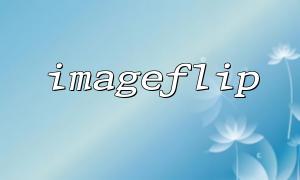In PHP, image processing is a very common task. Especially when we use the GD library for image creation and editing, imageflip and imagecolorallocate are two functions that are often used together. However, sometimes they can experience some problems with their combination, which leads to a worse end result than expected. This article will discuss these issues and how to solve them.
The imageflip function is used to flip an image along a vertical or horizontal axis. The imagecolorallocate function is used to assign a color to draw image elements. When these two functions are used together, you may encounter the following common problems:
Color distortion : After flipping the image, the color may change, causing the final image to be different from the original image.
Transparent background problem : If the image has transparent parts, the transparent parts may not be displayed correctly after flip.
Image resource issue : When flipping an image, the resources of the original image may be wrongly overwritten or cannot be released correctly.
Let's take a look at a simple example of how to encounter errors when using imageflip and imagecolorallocate .
<?php
// Create a new image
$image = imagecreatetruecolor(200, 200);
// Assign colors
$background_color = imagecolorallocate($image, 255, 255, 255); // White background
$color = imagecolorallocate($image, 0, 0, 0); // black
// Fill the background
imagefill($image, 0, 0, $background_color);
// Draw a rectangle
imagerectangle($image, 50, 50, 150, 150, $color);
// Flip the image
imageflip($image, IMG_FLIP_HORIZONTAL);
// Output image to browser
header('Content-Type: image/png');
imagepng($image);
imagedestroy($image);
?>
A common problem is that when flipping the image, the color looks something wrong. This problem usually occurs when color allocation is inconsistent.
Solution :
Make sure you assign the correct RGB value to each color in the imagecolorallocate function.
After using imageflip , reassign the color and check the color value of each pixel of the image to avoid color confusion due to resource conflicts.
If the image is a PNG image with a transparent background, flipping the image may cause the transparent parts to become opaque or display errors.
Solution :
When creating images, make sure you enable transparency support. You can use imagecolortransparent to specify transparent colors, or use imagealphableending() and imagesavealpha() to preserve transparent channels.
For example:
// Create transparent images
$image = imagecreatetruecolor(200, 200);
imagealphablending($image, false);
imagesavealpha($image, true);
// Transparent background color
$transparent = imagecolorallocatealpha($image, 0, 0, 0, 127); // Completely transparent
imagefill($image, 0, 0, $transparent);
// Draw content
imagerectangle($image, 50, 50, 150, 150, $color);
The imageflip function may sometimes cause the image resource to be released incorrectly, especially when processing large images, where memory overflow may occur.
Solution :
After image processing is finished, remember to call imagedestroy() to free up image resources to avoid memory leakage.
After flipping an image, some image elements may be lost or incompletely displayed, especially in the case of complex graphics and paths.
Solution :
Make sure that all drawing operations have been completed before calling the imageflip function. Avoid drawing again after flipping the image, as the coordinate system of the image may change after flipping.
When using imageflip and imagecolorallocate functions, the problems encountered mainly focus on color distortion, transparent background display errors, and image resource management. These problems can be effectively avoided through correct image creation, color allocation, and post-flip image processing. With these skills you can more efficiently process images in PHP.
I hope this article can help you solve the problems you may encounter when using these two functions and make your image processing work smoother!















